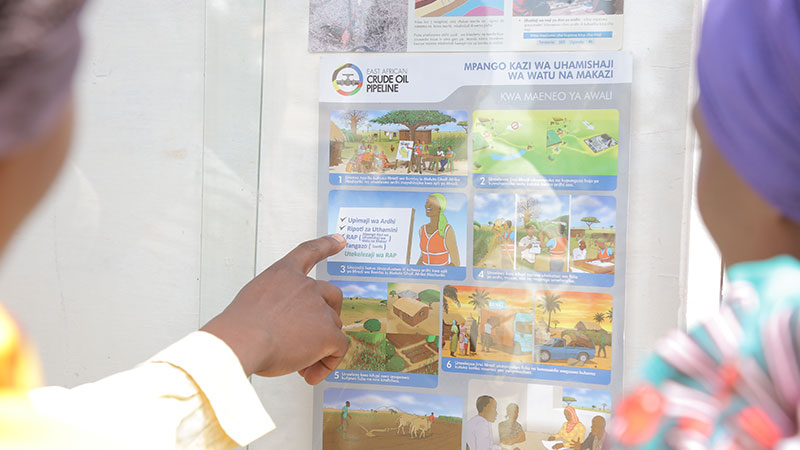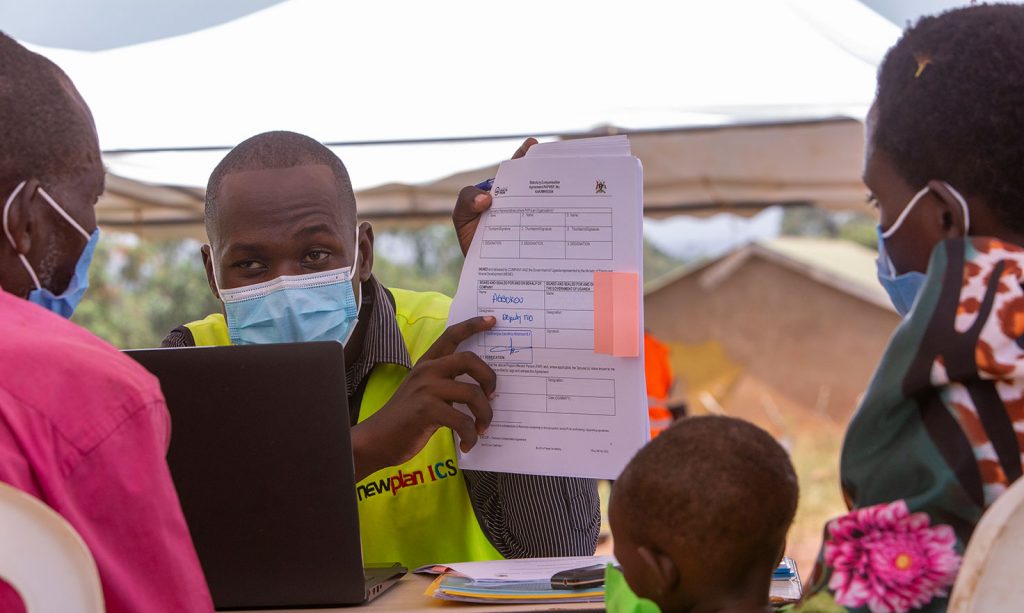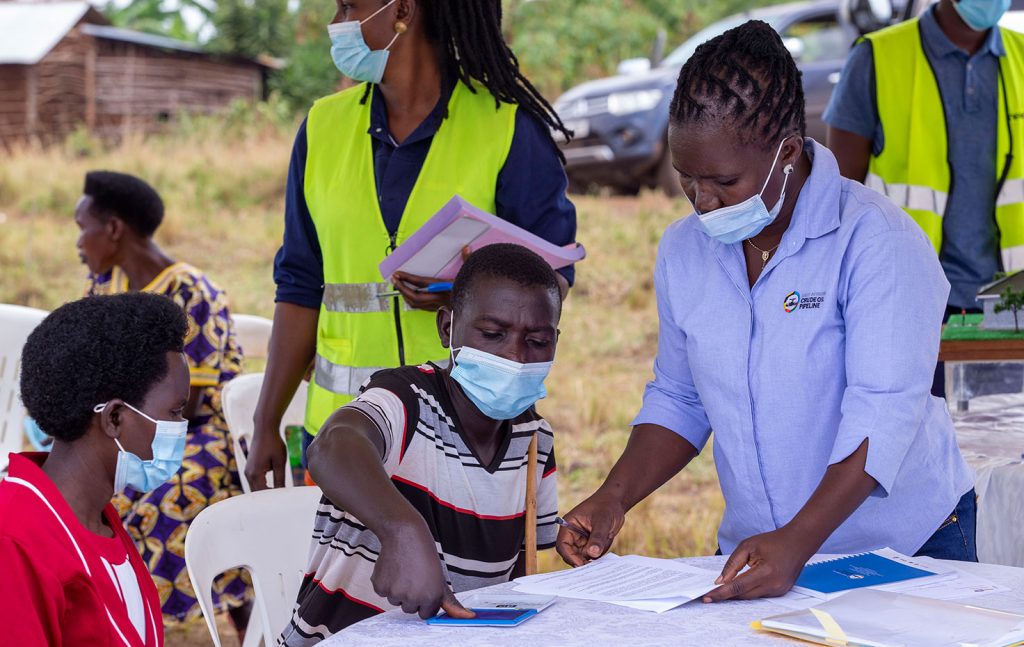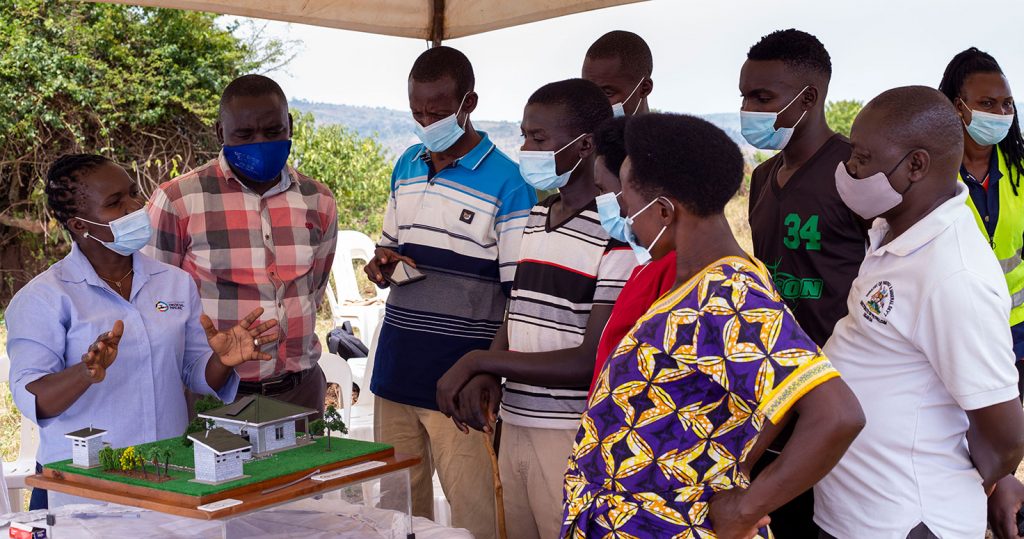EACOP requires land access for two main purposes:
1. Permanent facilities for the construction and operation of the pipeline,
- The 30m corridor in which the pipeline will be buried (also known as the right-of-way). This corridor may be slightly wider or narrower at some point.
- Above Ground Installations (pumping stations and pressure reduction stations.
- The Marine Storage Terminal at Tanga.
2. Priority Areas related to land required for construction purposes
- The Coating Plant area (where the individual pipe joints will be insulated)
- 16 Main Camp and Pipe Yards (MCPYs), used for construction camps and pipe storage during the construction phase. It is planned that 4 of these MCPYs in Tanzania will be converted to solar farms
There will also be both permanent and temporary access roads to the various facilities. The land acquisition process complies with National legislative requirements and the relevant International Financing Standards (IFS) captured in the Equator Principles (EP) IV and the Performance Standards (PS) of the International Finance Corporation (IFC).
Under the Host Government Agreements, it is set out that whilst EACOP is responsible for the execution of the land acquisition process including all administrative costs and payment of compensation, the land will be owned by the Host Governments and leased back to EACOP. These leases will be for 66 years for the permanent facilities and 5 years for the Priority Areas.
The overall pipeline route has been designed to minimize environmental and social impacts, but some physical displacement (loss of shelter) and economic displacement (full or partial loss of livelihoods) for communities is unavoidable. Individuals and households are affected to varying degrees by these impacts.
Summary statistics are tabulated below (PAPs = Project Affected Persons, broadly corresponding to households but also extending to institutions, community property etc).

A Resettlement Policy Framework (Tanzania) and ten Resettlement Action Plans (RAPs) have been developed for the Project – one RAP for the entire 296km Uganda section, and 9 RAPs for the 1147km Tanzanian section comprising of one RAP for the Priority Areas in Tanzania and eight RAPs for each of the Regions with permanent facilities.
These key documents describe the land required for the Project, the land acquisition process undertaken, the communities and households affected, the entitlements and eligibility of people for different types of compensation, vulnerable people affected by land acquisition, in-kind compensation options including replacement housing, transitional support, and livelihood restoration programmes as well as the implementation and monitoring plans.

In summary the RAPs set out EACOP Project commitments which include:
- Compliance with applicable national legislation and international financing standards requirements.
- Ensuring that all landowners and land users affected by the land acquisition process are treated with respect and receive compensation at full replacement value.
- Identifying vulnerable people affected by land acquisition and assisting them as necessary.
- Signing compensation agreements with each affected person, household, or institution
- Paying compensation and giving notice prior to accessing land
- Providing transitional support through food packages to eligible households
- Developing and implementing livelihood restoration programs for eligible households
- Constructing and providing replacement houses for physically displaced households.
Current Status
The initial land delineation and asset surveys were undertaken, valuation reports developed and then approved by the appropriate Authorities in the period 2018-2020.
Due to slippage in the timing of the final investment decision, there was a waiting period between this survey phase – known as RAP planning – and passing into the actual land acquisition phase – known as RAP Implementation.
During this waiting period, EACOP maintained a dialogue with PAPs informing them to continue to farm their land and take care of their trees and structures as usual (link to document showing this communication). Moreover, since PAPs had not had their compensation entitlements explained to them, signed their compensation agreements, or received their compensation, no PAPs were requested to leave their land.
Actual signing of compensation agreements and payment of compensation commenced
- In Tanzania, from July 2021 for the Priority Areas, with the first PAPs vacating their land in October 2021. This is now completed apart from the finalization of some replacement houses.
- In Tanzania this was followed with the start of the main right of way signing and compensation process in April 2022 and is expected to be completed in Q3 2023 (when the last replacement house is constructed).
- In Uganda the signing and compensation process for the Priority Areas was started in December 2021. It is still ongoing and expected to be completed before year end 2022 (last replacement house constructed)
- In Uganda the main Right of Way process was started in March 2022 and is expected to complete in Q2 2023 (last replacement house constructed)
Compensation Calculation
The way that cash compensation is calculated is not identical between the two countries, but broadly consists of the following elements resulting in full replacement value being paid;
- An inventory is recorded for each PAP (land, trees, crops, structures or other assets)
- Compensation rates are established and approved by the respective Chief Valuer
- The compensation value is then calculated by cross-multiplying the inventory by the compensation rates
- A disturbance allowance is then applied
- Other allowances such as for transport or grave relocation according to the national requirements are then applied if relevant
- An uplift/interest factor is applied to compensation and allowances to ensure that compensation considers the delays between surveying and the actual payment of compensation such that it meets full replacement value at the time it is paid.
PAPs have access to a Grievance Mechanism

Payment of Compensation
EACOP has assisted PAPs to open bank accounts with their spouses and provide them with financial literacy training. These accounts are operated free of charge. Compensation is currently being paid to those households that have signed their compensation agreement. Given the time elapsed since the initial valuation, compensation values have been uplifted to reflect full replacement value at the time when compensation is being paid.
After payment of compensation and closer to the time when land access is needed, EACOP will issue the household with a notice to vacate. During this period, EACOP supports the household to harvest crops, salvage any materials and vacate the land.
Once households leave their land, EACOP starts providing eligible households with additional in kind compensation including transitional support (food baskets) and livelihood restoration programmes.

Replacement House Construction
Physically displaced PAPs are encouraged to choose replacement houses rather than cash compensation. These choices were made in both Uganda and Tanzania starting in 2021 and the first half of 2022. Almost 90% of eligible PAPs have elected for replacement houses
EACOP engaged with affected households during the design of replacement houses by national architects. The size of the replacement houses is equal to or larger than the existing structure; the houses are built to a higher standard compared to existing structures and align with national guidelines and requirements. In addition to houses, external kitchens and ventilated improved pit latrines are also built. Houses are equipped with a solar panel and rainwater water harvesting & storage systems.
Housing designs and options are fully disclosed to enable affected households to make an informed choice between replacement houses or cash compensation. Households are involved in the design of the layout of the replacement housing and ancillary structures on their plots prior to the start of construction.
Construction of replacement houses is ongoing and will be completed prior to these households receiving notice to vacate their land. The general objective consistent with best practice is that the PAPs move directly to their new permanent home; temporary housing may be used in very specific circumstances.

Livelihood Restoration Programmes
Livelihood restoration programmes are accessible to eligible Project Affected Persons and their households. The types of Livelihood Programmes are described in the RAPs and adapted to local conditions and needs. There is a strong focus on support for agriculture, crop diversification, livestock management and enterprise development.
As an example, at the coating plant site in Tanzania, the first harvest for affected households was significantly increased following the training, support and inputs provided. Livelihood restoration programmes are expected to run for 2-3 years until households’ livelihoods are restored.
